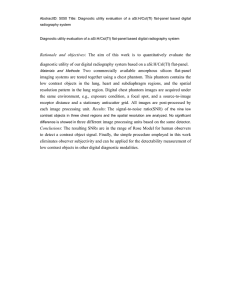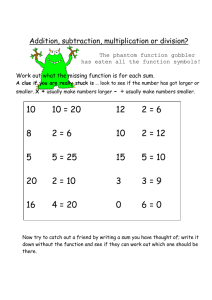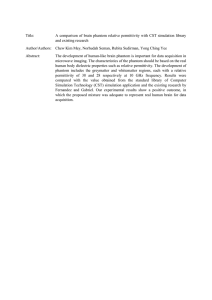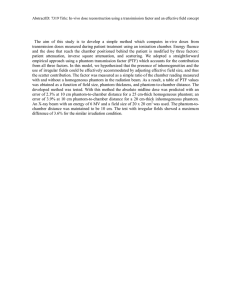Phantom Load Poster Final
advertisement
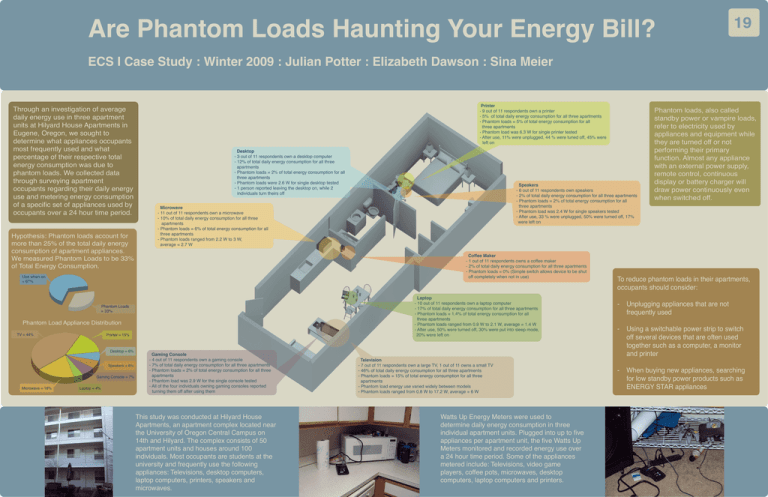
Are Phantom Loads Haunting Your Energy Bill? 19 ECS I Case Study : Winter 2009 : Julian Potter : Elizabeth Dawson : Sina Meier Through an investigation of average daily energy use in three apartment units at Hilyard House Apartments in Eugene, Oregon, we sought to determine what appliances occupants most frequently used and what percentage of their respective total energy consumption was due to phantom loads. We collected data through surveying apartment occupants regarding their daily energy use and metering energy consumption of a specific set of appliances used by occupants over a 24 hour time period. Hypothesis: Phantom loads account for more than 25% of the total daily energy consumption of apartment appliances. We measured Phantom Loads to be 33% of Total Energy Consumption. Printer - 9 out of 11 respondents own a printer - 5% of total daily energy consumption for all three apartments - Phantom loads = 5% of total energy consumption for all three apartments - Phantom load was 6.3 W for single printer tested - After use, 11% were unplugged, 44 % were tuned off, 45% were left on Desktop - 3 out of 11 respondents own a desktop computer - 12% of total daily energy consumption for all three apartments - Phantom loads = 2% of total energy consumption for all three apartments - Phantom loads were 2.6 W for single desktop tested - 1 person reported leaving the desktop on, while 2 individuals turn theirs off Microwave - 11 out of 11 respondents own a microwave - 10% of total daily energy consumption for all three apartments - Phantom loads = 6% of total energy consumption for all three apartments - Phantom loads ranged from 2.2 W to 3 W, average = 2.7 W Coffee Maker - 1 out of 11 respondents owns a coffee maker - 2% of total daily energy consumption for all three apartments - Phantom loads = 0% (Simple switch allows device to be shut off completely when not in use) Use when on = 67% Laptop - 10 out of 11 respondents own a laptop computer - 17% of total daily energy consumption for all three apartments - Phantom loads = 1.4% of total energy consumption for all three apartments - Phantom loads ranged from 0.9 W to 2.1 W, average = 1.4 W - After use, 50% were turned off, 30% were put into sleep mode, 20% were left on Phantom Loads = 33% Phantom Load Appliance Distribution TV = 44% Printer = 15% Desktop = 6% Speakers = 6% Gaming Console = 7% Microwave = 18% Laptop = 4% Speakers - 6 out of 11 respondents own speakers - 2% of total daily energy consumption for all three apartments - Phantom loads = 2% of total energy consumption for all three apartments - Phantom load was 2.4 W for single speakers tested - After use, 33 % were unplugged, 50% were turned off, 17% were left on Gaming Console - 4 out of 11 respondents own a gaming console - 7% of total daily energy consumption for all three apartments - Phantom loads = 2% of total energy consumption for all three apartments - Phantom load was 2.9 W for the single console tested - All of the four individuals owning gaming consoles reported turning them off after using them This study was conducted at Hilyard House Apartments, an apartment complex located near the University of Oregon Central Campus on 14th and Hilyard. The complex consists of 50 apartment units and houses around 100 individuals. Most occupants are students at the university and frequently use the following appliances: Televisions, desktop computers, laptop computers, printers, speakers and microwaves. Television - 7 out of 11 respondents own a large TV, 1 out of 11 owns a small TV - 46% of total daily energy consumption for all three apartments - Phantom loads = 15% of total energy consumption for all three apartments - Phantom load energy use varied widely between models - Phantom loads ranged from 0.8 W to 17.2 W, average = 6 W Watts Up Energy Meters were used to determine daily energy consumption in three individual apartment units. Plugged into up to five appliances per apartment unit, the five Watts Up Meters monitored and recorded energy use over a 24 hour time period. Some of the appliances metered include: Televisions, video game players, coffee pots, microwaves, desktop computers, laptop computers and printers. Phantom loads, also called standby power or vampire loads, refer to electricity used by appliances and equipment while they are turned off or not performing their primary function. Almost any appliance with an external power supply, remote control, continuous display or battery charger will draw power continuously even when switched off. To reduce phantom loads in their apartments, occupants should consider: - Unplugging appliances that are not frequently used - Using a switchable power strip to switch off several devices that are often used together such as a computer, a monitor and printer - When buying new appliances, searching for low standby power products such as ENERGY STAR appliances
